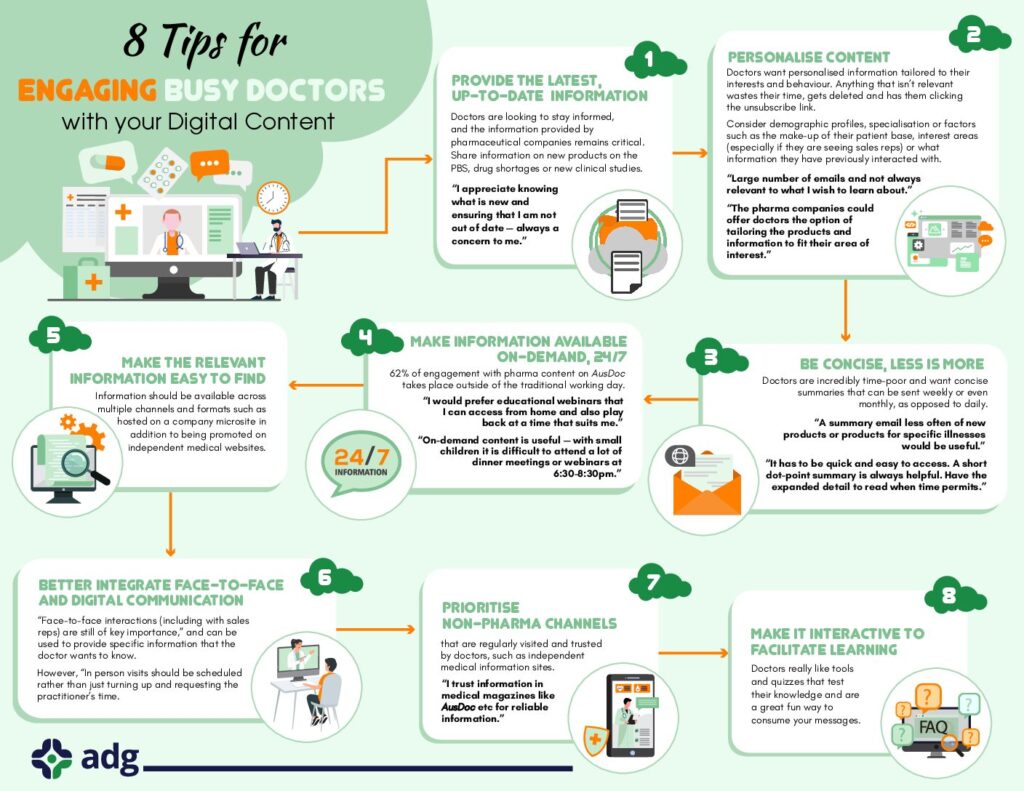The digital revolution has had a significant positive impact on how doctors’ access pharmaceutical information, especially in the post-COVID-19 era. This has ultimately enhanced the quality use of medicines and patient care.
More recently, with the ubiquitous use of the word ’omnichannel’, the short-term challenge for pharma is finding the right mix between traditional face-to-face engagement and digital channels, both personalised to individual needs and creating a meaningful information toolkit for each doctor.
So, what should pharmaceutical companies and their representatives consider going forward? This is what Australian doctors said:
1. Provide the latest, up-to-date information
Doctors are looking to stay informed, and the information provided by pharmaceutical companies remains critical. In particular, share information on new products that are on the PBS, drug shortages or new clinical studies.
Doctors are looking to stay informed, and the information provided by pharmaceutical companies remains critical. In particular, share information on new products that are on the PBS, drug shortages or new clinical studies.
“I appreciate knowing what is new and ensuring that I am not out of date — always a concern to me.”
“I find email updates about medications the easiest way to keep up to date.”
2. Personalise content
Doctors want personalised information tailored to their interests and behaviour. Anything that isn’t relevant wastes their time, gets deleted and has them clicking the unsubscribe link.
Consider demographic profiles, specialisation or factors such as the make-up of their patient base, interest areas (especially if they are seeing sales reps) or what information they have previously interacted with.
“Large number of emails and not always relevant to what I wish to learn about.”
“The pharma companies could offer doctors the option of tailoring the products and information to fit their area of interest.”
3. Be concise, less is more
Doctors are incredibly time-poor and want concise summaries that can be sent weekly or even monthly, as opposed to daily.
“A summary email less often of new products or products for specific illnesses would be useful.”
“It has to be quick and easy to access. A short dot-point summary is always helpful. Have the expanded detail to read when time permits.”
4. Make information available on-demand, 24/7
62% of engagement with pharma content on AusDoc takes place outside of the traditional working day.
“I would prefer educational webinars that I can access from home and also play back at a time that suits me.”
“On-demand content is useful — with small children it is difficult to attend a lot of dinner meetings or webinars at 6:30-8:30pm.”
5. Make the relevant information easy to find
Information should be available across multiple channels and formats such as hosted on a company microsite in addition to being promoted on independent medical websites.
6. Better integrate face-to-face and digital communication
“Face-to-face interactions (including with sales reps) are still of key importance,” and can be used to provide specific information that the doctor wants to know.
However, “In person visits should be scheduled rather than just turning up and requesting the practitioner’s time.”
7. Prioritise non-pharma channels
Prioritise those non-pharma channels that are regularly visited and trusted by doctors, such as independent medical information sites.
“I usually trust information in medical magazines like AusDoc etc for reliable information.”
8. Make it interactive to facilitate learnings
Doctors really like tools and quizzes that test their knowledge and are a great fun way to consume your messages.

